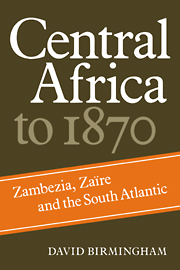3 - Ivory and Guns in the nineteenth century
Published online by Cambridge University Press: 05 June 2012
Summary
In the nineteenth century Central Africa remained as it is today one of the most thinly populated of the habitable areas of Africa. Currently averaging about six people to the square kilometre, or about one sixth of the density found in the wooded areas of West Africa, Central Africa has no great concentrations of rural population, such as are found in the Niger delta to the west, or in the interlacustrine highlands to the east, and the only urban growth has been in recent commercial, administrative and mining centres such as Duala, Bangui, Kinshasa, Luanda and Ndola.
Late in the nineteenth century Central Africa was divided into four political zones which are reflected in the subsequent history of the area. The central and north-eastern zone consists of the republic of Zaïre, an area of about i million square miles and twenty millionpeople, who were ruled during the first half of the twentieth century by Belgium. The south-west consists of Portuguese-speaking Angola, an area of half a million square miles and five million people. In the quarters adjacent to these two huge territories there developed the spheres of British influence in the south-east, and of French influence in the north-west. The Cameroun section of the French sphere was under German rule from 1884 to 1914, and a small pocket of the northern Gabon forest is Spanish-speaking. Three of the four main colonial influences had their roots in the pre-1875 period. The Portuguese and French had traded extensively along the coasts north and south of the Zaïre river, from the fifteenth and seventeenth centuries respectively, and the Portuguese had created settlements in Angola and Benguela.
- Type
- Chapter
- Information
- Central Africa to 1870Zambezia, Zaire and the South Atlantic, pp. 108 - 155Publisher: Cambridge University PressPrint publication year: 1982



